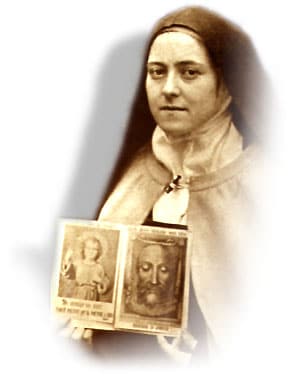St Therese of Lisieux (1873-1897) was a French Catholic who became a Carmelite nun at an early age. She died in obscurity at the age of 24. However, after her death, her autobiography – Story of a Soul was published and became a best-seller around the world. Her books explained her spiritual path of love and selflessness, and she became one of only three females to be considered a doctor of the Catholic Church.
Short bio of St Therese of Lisieux


St Therese was drawn to pray for sinners. Although her father tried to keep newspapers out of the house, she became aware of the notorious – unrepentant killer Henri Pranzini, who was due to be executed in 1887. Therese prayed for his last-minute conversion and was able to read in the newspaper of his last-minute grab for a crucifix as he approached the scaffold. He kissed the wounds of Jesus three times before being guillotined.
St Therese audience with the Pope
Initially, the Church authorities refused to allow a girl, who was so young to enter holy orders. They advised her to come back when she was 21 and “grown up”. However Therese’s mind was made up, she couldn’t bear to wait; she felt God was calling her to enter the cloistered life. Therese was so determined she travelled to the Vatican to personally petition the Pope. Breaking protocol she spoke to the Pope asking for permission to enter a convent. Slightly taken aback Pope Leo XIII replied: “Well, my child, do what the superiors decide.” Soon after, her heart’s desire was fulfilled, and she was able to join her two sisters in the Carmelite convent of Lisieux.
“Our fulcrum is God: our lever, prayer; prayer which burns with love. With that we can lift the world!”
– St Therese

Love attracts love, mine rushes forth unto Thee, it would fain fill up the abyss which attracts it; but alas! it is not even as one drop of dew lost in the Ocean. To love Thee as Thou lovest me I must borrow Thy very Love – then only, can I find rest.
– St Therese
This was the “little way” which Therese sought to follow. Her philosophy was that – what was important was not doing great works, but doing little things with the power of love. She believed that if we can maintain the right attitude, then nothing shall remain that can’t be accomplished.
Therese had the ambition to become a missionary and travel to Africa or China. However, ill health curtailed these plans, and she was forced to stay in the convent.
Towards the end of her life, when she was increasingly bed-ridden, St Therese was encouraged by the elder nuns to write down her way of spiritual practice. She wrote three books that explained her “little way” and included her personal spiritual autobiography ‘Story of a Soul’.
“The good God does not need years to accomplish His work of love in a soul; one ray from His Heart can, in an instant, make His flower bloom for eternity…”
– St Therese
St Therese died tragically early at the age of 24 from tuberculosis. However after her death, the writings became avidly read by, first other nuns, and then the wider Catholic community. Although initially intended only for a small audience, her books have frequently been republished. In 1997, St Therese was declared one of the only three female Doctors of the Catholic Church (there are 33 doctors of the church in total). Thus after her death, she was able to achieve her intuitive feeling that she would be able to do something great and help save souls.
St Therese was canonized by Pope Pius XI on May 17, 1925, only 26 years after her death.
Pope Francis (elected 2013) has said St Therese is his favourite saint and keeps a picture of her on his bookcase. Explaining his choice for St Therese, Pope Francis remarked
“Do not be afraid to depend solely on the tenderness of God as Saint Thérèse of Lisieux did, who, for this reason, is a beloved daughter of the Blessed Mother and a great missionary saint.” (1)
He has also remarked: “When I have a problem I ask the saint, not to solve it, but to take it in her hands and help me accept it.”
Citation: Pettinger, Tejvan. “Biography of St Therese of Lisieux”, Oxford, UK – www.biographyonline.net. Last updated 12th Jan 2018
Story of a Soul: The Autobiography of St. Therese of Lisieux
Story of a Soul: The Autobiography of St. Therese of Lisieux at Amazon
The Little Way for Every Day: Thoughts from Therese of Lisieux
The Little Way for Every Day: Thoughts from Therese of Lisieux at Amazon
Related pages


- Biography of St Therese at the Society of Little Flower
- St Therese of Lisieux at Write Spirit


